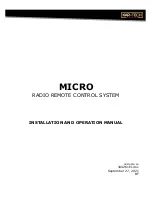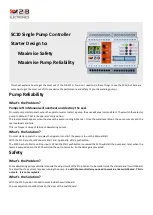
© Danfoss | DCS (MWA) | 2016.12
DKRCI.PI.HS1.B4.ML | 520H6627 | 5
ENGLISH
Assembly
Remove welding debris and any dirt from
pipes and valve body before assembly.
Check that the o-rings are intact before
replacing the function module. If possible,
apply some refrigeration oil to ease the
insertion and to protect the o-rings. Check
that the top gasket has not been damaged. If
the surface has been damaged or the gasket
has been bent, it must be replaced.
Tightening (fig. 6)
Tighten the top cover with a torque wrench,
to the values indicated in the table.
Colours and identification
The ICLX valves are Zinc-Chromated from
factory. The Zinc-Chromatization does not
cover the welding connections. If further
corrosion protection is required, the valves
can be painted.
The external surface of the valve housing
must be protected against corrosion with
a suitable top coating after installation
involving welding and consequent assembly.
Protection of the ID plate when painting the
valve is recommended.
Important note for ICLX valves:
The ICLX valve is kept in its open
position by hot gas. The hot gas
condenses in the cold valve and
creates liquid under the servo piston.
When the pilot valves change status to close
the ICLX, the pressure on the servo piston
equalises with the suction pressure through
the pilot valve.
This equalisation takes time because
condensed liquid is present in the valve.
The exact time taken from when the pilot
valves change position to complete closing
of the ICLX will depend on temperature,
pressure, refrigerant and size of valve. Thus
an exact closing time for the valves cannot
be given but, in general, lower temperatures
give longer closing times.
It is very important to take the closing times
into consideration when hot gas defrost is
performed on evaporators.
Steps must be taken to ensure that the
hot gas supply valve is not opened before
the ICLX in the suction line is completely
closed. If the hot gas supply valve is opened
before the ICLX in the suction line is closed,
considerable energy will be lost and
potentially dangerous situations might arise
because of “liquid hammer”. In ICLX valves,
the spring-loaded second stage might be
induced to hammer by gas and liquid being
forced through the valve at Δp > 1.5 bar
across the ICLX. The final result could be
severe damage to the valve.
As a rule of thumb a closing time of 2
minutes can be used as a starting point.
The optimum closing time for each
individual system must be determined
at initial start-up of the plant at intended
operational conditions. It is recommended
to check if the closing time needs to be
changed when conditions changes (suction
pressure, ambient temp. etc.) and closing
time should be checked at service of the
valve.
Once the optimum closing time has been
identified it is recommended to add a safety
margin of 30 sec. to the optimum closing
time.
Maintenance
Service
The ICLX valves can be disassembled for
service purposes.
Only skilled and trained refrigeration
engineers are allowed to service the ICLX
valves.
Do not open the valve while the valve is still
under pressure.
Pressure relief can be done by carefully
opening the manual operating spindle.
Small grooves along the thread will release
refrigerant into open air. This operation must
only be done after providing the correct
countermeasures under local legislation.
The function module can be lifted out by
applying a vertical force on the grooves
shown in figure 3.
Upon opening and removal of the function
module:
- Check that the o-rings on the function
module has not been damaged.
A valve with a damaged o-ring might not
operate according to the specification.
- The insert and piston assembly can be
disassembled according to figure 8b & 8c.
Be careful when removing the retaining
ring (fig. 8b, pos. 7). The retaining ring (fig.
8b, pos. 7) will be submitted to the force
from the compressed spring (fig 8b, pos. 5).
Be careful not to damage the two
Seal Seats shown in fig. 8b and 8c
since any deformation of the steel
surface will lead to malfunction of
the valve
- Check pistons, cylinders and valve plates
for wear and scratches and replace if
needed.
- Check that the movement of the pistons
and valve seats are free and with low
friction.
Replacement of Valve Plates
(ordinary wear parts)
It is possible to replace the two PTFE valve
plates (fig. 8c, pos. 2 and pos. 5) by following
fig. 9 and these instructions:
Fig. 9a, pos.1 shows a tool (purpose made)
that fits into the hole pattern of the sealing
retainer (pos. 3) of the piston assembly.
As backstop when unscrewing the sealing
retainer it is recommended to make an
arrangement of two steel pins that fits into
the female hexagon holes of the Allen bolts
(fig. 8c, pos. 9), clamped into a vice (fig. 9a,
pos. 2).
Once the sealing retainer is removed, the
Valve plate (pos. 4) can be lifted out.
Move the two steel pins (fig. 9b, pos.2) to a
higher position in the vice to allow the bleed
piston (fig. 9b, pos. 3) to be slided downwards
and expose two elongated holes (pos.4).
While there is access to the holes (pos. 4) a
steel bar (pos.5) with matching dimensions
is inserted through the two opposed holes
with tool pos. 1 (or similar fork tool) bridging
the bar.
Unscrew the main piston (fig. 9b, pos. 6).
For disassembling of the last sealing retainer
it is recommended to utilise a mandrel with
three point suspension to avoid deformation
of the surfaces (fig. 9c).
Clamp the bleed piston carefully to the
mandrel at surface pos.1. Block the mandrel
from rotation and unscrew the sealing
retainer with a tool (pos.2) manufactured for
the purpose.
When the sealing retainer is removed
the remaining valve plate (pos. 3) can be
replaced.
Reassembling of the piston assembly is done
in reverse order. The torque values for the
different joints are shown in fig. 9.
Assembly
Remove any dirt from the body before the
valve is assembled. Check that all channels
in the valve are not blocked by particles or
similar.
If possible, apply some refrigeration oil to ease
the insertion and to protect the o-rings.
Tightening (fig. 6)
Tighten the top cover with a torque wrench, to
the values indicated in the table.
Changing from two step to
one step function
The ICLX valve is from factory side setup as
two step function. To change the opening
characteristics to one step function the
following step must be completed:
- Remove the function module from the
valves house (fig 3.).
- Remove the locking ring, upper spring
retainer, spring and lower spring retainer
(fig. 4).
- Change the two bolts (fig 8c, pos. 9).
- The length of the two bolts corresponds
to the desired characteristic of the valve
and should be applied according to the
table (fig. 4).
- After changing the bolts the valve can be
reassembled.
Manual opening device (fig. 7)
Normal operation mode
For the valve to operate normally under the
influence of the pilot valves the spindle of the
manual operation device needs to be turned
fully clockwise until the locking ring (A) sits
on the top of the packing gland.
Manual
forced opening
To manually open the valve the spindle of the
manual operation device needs to be turned
fully counter clockwise until hitting the
mechanical stop.
Commissioning
The time span required to secure full closing
of the ICLX valve depends on valve size and
application, and needs to be investigated
on site. The optimum should be determined
during commissioning.
Use only original Danfoss parts, including
O-rings and gaskets for replacement.
Materials of new parts are certified for the
relevant refrigerant.
In cases of doubt, please contact Danfoss.
Drawings are only for illustration, not for
dimensioning or construction.






































